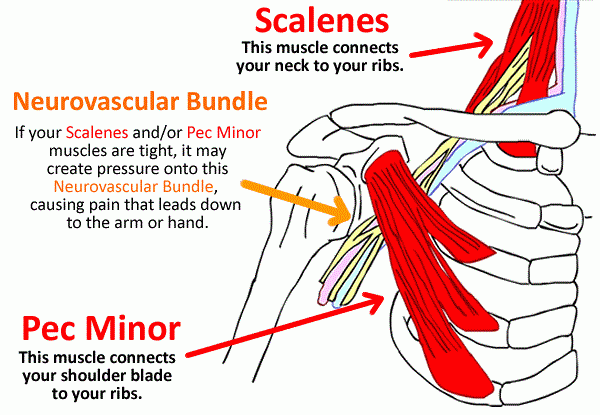Tingling in the Shoulder Blade – Causes & Natural Treatment

Tingling and numbness can be unpleasant physical sensations that can be felt at the extremes of the body, like shoulder, knees, arms, and toes. Tingling in the shoulder blade can result from a decrease in blood flow. The good news is that it can be treated without medicines. There are a lot of aspects that contribute to the numbness in your shoulder.
In this post, we’ll study how the tingling in the shoulder blade feels, what are the causes, and what is the best natural way to get rid of such shoulder numbness.
Tingling in shoulder blade – What is it exactly?
People describe shoulder tingling and numbness as uncomfortable bodily sensations. The level of intensity of tingling near shoulder blade varies from individual to individual. There are generally two types of tingling in the shoulder blade:
- Paresthesia:
This feeling is expressed as pins and needles in the shoulder blade. It can simulate the feeling of a foot falling asleep, which most of us are acquainted with. While you are facing numbness, physical discomfort and sharpness are also evident.
- Dysesthesia:
Dysesthesia can manifest itself in a variety of ways. Many people experience itchiness or blistering on their skin. It may even feel as if the area is contracting around your neck. In such a situation, don’t try to crack your neck, or shoulder blade.
Both of these conditions are considered harmless, but one should not take such a buzzing feeling in shoulder blade lightly. People should seek medical assistance as soon as possible. Otherwise, prolonged conditions like these can lead to severe symptoms making life more complicated.
What causes tingling in shoulder blade?
Paresthesia may result from a decrease in blood flow to the lower extremities. This can be reduced by simply applying pressure to the blood vessels, or in other words by – tightening them. Nervous system damage can also cause tingling in the shoulder and neck.
Let’s look at various reasons that are responsible for the sensation of shoulder blade tingling.
Causes of Numb Shoulder Blade

Nerve Damage:
The leading cause of numbness and tingling between shoulder blades is nerve damage. It includes normal tears to the shoulder blade and neck areas. A pinched nerve occurs when a nerve is put under a lot of stress. This could come from:
- Muscle, soft tissue, or joints infringing on the nerve
- Bruising or swelling covering the nerve
- Stress or excessive use of any surrounding skin
Nerve damage can occur because of stress. This prevents the nerve from usually working—neck pain, loss of strength, numbness in scapula, or tingling in right shoulder blade.
Damage to Rotator Cuff:
The rotator cuff is a band of tendons that wraps around the shoulder girdle. It functions similarly to a substantial elastic band to keep the forearm bone (upper arm bone) in the shoulder socket. The rotator cuff can be strained due to daily wear and tear or damage.
Overuse of the shoulder can result in rotator cuff harm. This can happen due to physical movement at the job or during workouts. On the other hand, a sedentary lifestyle can increase the probability of pressing the nerves surrounding the rotator cuff, causing tingling in the tingly shoulder blade.
Bursitis:
Bursae are fluid-filled sacs found within your shoulder joint and other joint capsules. They function similarly to bearing, padding motion between bone fragments. This reduces friction.
Bursitis is a condition in which the bursae become irritated and inflamed. Swelling infuriates nerves, resulting in shoulder and arm pain. It can occur in the shoulder if it is overused or injured. Rotator cuff injury problems frequently cause bursitis.
Spurs:
Spurs are coagulated regions of bone that are typically not hurtful. They can occur as a result of joint damage. They can appear for no apparent purpose at times.
Nerves can be pinched or irritated by bone spurs because their spaces are narrowed. This can cause tingling in your left shoulder blade or make your shoulders uncomfortable and stiff.
Good Read: Here’s all you need to know about chiropractic care for babies.
Chiropractic Treatment for Tingling in the Shoulder Blade
If you recognize that the scapula tingling sensation is not life-threatening but it is not subsiding on its own, you should schedule an appointment with a chiropractor for treatment.
Truly speaking, there’s no such medicine that works to immediately stop the tingling sensation in your right or left shoulders. However, a massage or some shoulder exercises might help you subdue the severe pain and unpleasant feeling. Chiropractors have been known to treat such conditions through massage and some shoulder or cervical spine adjustments.
Why Should You Opt for Chiropractic Treatment?
Chiropractic treatment can help you get rid of the tingling sensation substantially, and it is better than regular treatment due to the following reasons:
First, chiropractic treatment involves influencing the musculoskeletal system rather than just acknowledging shoulder pain. It implies that your joints, cartilage, vertebrae, ligaments, tendons, and soft tissues will be examined deeply. Therefore, chiropractic treatment is the best way to go if you want to get to the root of the tingling in shoulder blades.
Secondly, chiropractic treatment emphasizes non-invasive, non-surgical therapies and natural care as the first line of defence. While regular medical treatment will help reduce the pain through medicines, chiropractic treatment will help you learn the cause of the pain and get rid of it permanently by using physical procedures.

How does chiropractic care for shoulder blade tingling work?
Being an alternative medicine treatment, chiropractic can be quite useful in treating tingling in shoulder blade. Here’s what chiropractors do.
- Diagnostics for Shoulder Pain:
Diagnosing the source of shoulder tingling is an essential milestone toward remedy and recovery. A screening exam from a chiropractor may include orthopedic tests to assess muscular sensations and physical function in your back and shoulders. In some situations, your primary care doctor or chiropractor may advise you to undergo diagnostic procedures, such as a CT scan or an MRI, before undergoing alternative treatments.
- Chiropractic Adjustments:
Chiropractic adjustments can often offer comforting assistance. A chiropractor will also discuss your standard of living and practices with you. If your lifestyle habits caused the irritation that resulted in the tingling in the shoulder blade, you need to do exercise to correct your poor posture. Chiropractic adjustments are deemed effective in relieving shoulder blade tingling. This treatment can weaken the symptoms, eventually leading to full recovery.
- Strengthening Exercises and Posture Treatment:
Many chiropractors will help you correct any discrepancies or obstructions holding back regular nerve activity is frequently included. The essential factor is to alleviate the pressure on your shoulder nerves to restore oxygen and blood flow to the region.
- Vibration Therapy:
Many people experience rigid shoulders that can hinder many things in a person’s way. This leads to numbness in the shoulder blade and, if untreated, can lead to permanent damage. The chiropractor will use vibration therapy for this purpose to help move the muscles and tissues of the shoulder for flexibility. Body therapy is considered very useful when treating numbness in the shoulder. The progress is slow, but it helps you reduce your symptoms in the best way.
Final Thoughts
First, make sure there isn’t a severe medical crisis. If you’re confident that the tingling in the shoulder blade isn’t putting you in serious jeopardy, it’s time to see a chiropractor.
This is your moment to figure out what’s trying to cause your tingling sensations in the shoulders. Chiropractic treatment will assist you in learning the underlying problem and dealing with it through non-invasive and natural procedures such as chiropractic adjustments.
Also Read: a complete guide to spinal decompression therapy




